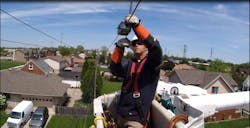In the last few years, devastating wildfires have ripped through many areas of the U.S. and globe. Recently, fires have devastated parts of Australia, driving residents and tourists out of towns up and down the country's East Coast.
The Wall Street Journal recently asked three experts about what could be done to mitigate wildfire risks. These experts. James L. Sweeney, professor, management science and engineering, Stanford University, and senior fellow of the Hoover Institution; Alexandra “Sascha” von Meier, director, Electric Grid Research, California Institute for Energy and Environment at the University of California at Berkeley; and Michael Wara, director, Climate and Energy Policy Program, Woods Institute for the Environment, Stanford University, discussed a wide range of strategies that could help combat risks.
Learn how to gain situational awareness to reduce wildfire threats. Download the application guide.
These include changing in local codes and land-use laws to prevent building in wilderness areas especially prone to fires and grid-hardening techniques such as undergrounding transmission and distribution lines and encouraging the development of microgrids. But all these strategies require government and utility cooperation, new laws, and lots of investment.
Ultimately, transmitting electricity across arid terrains is inherently risky.
“We can do a number of things to reduce wildfire risk around high voltage, but none of them is perfect…high voltage, dry grass, and high winds are just an inherently dangerous combination,”
Von Meier told the WSJ.
So, what can utilities do to gain situational awareness into conditions on transmission and distribution lines to help them pinpoint rand mitigate wildfire risks?
Today, system operators have used sensor-enabled analytics to gain situational awareness of dangerous conditions and resolve them before a fire starts and impacts customers. Smart grid sensors can be deployed across broad sections of a utility’s territory to provide immediate visibility to distribution and sub-transmission lines, especially in remote areas. Lineworkers can install the sensors within minutes, and circuit owners can remotely provision or configure them.
Smart grid sensors and analytics can help identify and mitigate wildfire threats by:
1: Identifying specific patterns of line disturbances might indicate fire threats, managing vegetation or other obstructions could cause sparks and lead to fires, and locating energized, downed power lines that could spark fires.
2: Providing load and voltage data in near real-time so that utilities can maintain situational awareness around problem areas or at the sites of mobile substations or generators.
3: Confirming switching operations and verifying outage restoration as circuits are returned to their original and normal configurations.
Download the application guide, Wildfire Mitigation with Sensors and Analytics, to learn how smart grid sensors can help utilities manage wildfire risks today.
Sponsored by:

